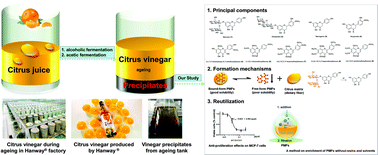Characterization of precipitation from citrus vinegar during ageing: chemical constituents, formation mechanism and anti-proliferative effect†
Abstract
Precipitation formation commonly occurs in the ageing step of fermented citrus vinegar. Hitherto, the chemical characteristics and biological properties of precipitates remain unveiled. This study focused on investigating the chemical profile, formation mechanism and biological repurposing of precipitates. Nine principal components, two flavonoid glycosides and their aglycones along with five polymethoxyflavones (PMFs), were identified from a methanol extract of precipitates. Using hydrolysis models, we demonstrated that insoluble aglycones were generated through the breakage of glycosidic bonds in flavonoid glycosides under acidic condition. Moreover, soluble bound-PMFs were destroyed by yeast–acid hybrid catalysis to release insoluble free-PMFs to form precipitates. A methanol extract of precipitates exhibited a potent anti-proliferative effect on MCF-7 cells (IC50 = 0.032 μg μL−1) via inhibiting tubulin polymerization. This study will be helpful for the food industry to aid optimizing citrus vinegar brewing and for reutilizing precipitates for functional foods and health products. Furthermore, it also provides a green strategy of PMFs enrichment from citrus using an enzyme–acid hybrid system.

- This article is part of the themed collection: Food & Function HOT Articles 2022


 Please wait while we load your content...
Please wait while we load your content...